Craft, Camp, and Color: Majolica in Drag explores the intersection of pottery and performativity in mid-nineteenth- century majolica ware. Characterized by saturated colors and polychrome glazes, majolica was wildly popular in white upper- and middle- class homes in Great Britain and the United States. With an expansive repertoire—from plates, teapots, and oyster trays to vases and garden stools—majolica objects variously exhibit seriousness, humor, sentimentality, and excess. The incredible array of majolica configurations was made possible by factory production and dangerous working conditions. Additionally, easy access to majolica ceramics supported a trend of nineteenth-century mass consumption. Viewing majolica through twenty-first-century eyes can obscure the appeal of spectacular objects such as a showstopper peacock. However, closer examination reveals that the polychrome glazes and playful subject matter of many majolica objects evoke narratives that are at turns fantastical and perplexing.
Majolica in Drag Interviews
Over the course of five weeks, seven Bard Graduate Center (BGC) teen interns immersed themselves in the overlapping cultures of majolica and drag. The teen interns interrogated the way majolica objects perform and how these crafted objects have been leveraged as expressions of personal and class identities. They challenged and deepened their first impressions of majolica by conducting interviews with contemporary performing artists. The teen interns led rich conversations that looked closely at artists’ performative practices and sought to understand majolica objects as performers in their own right. The majolica objects they selected bring to center stage larger questions about camp and aesthetics, taste and accessibility, and the hierarchies of high and low art.
Click Image to Read
BGC Intern Selects: Majolica Mania
Marker, slate, sound! Several members of the Craft, Camp, and Color: Majolica in Drag cohort have curated multi-media juxtapositions with majolica objects. This project draws on the Gesamtkunstwerk aesthetic of drag performances—in particular, the artistic union created by a performer’s costuming, theatricality, sets, music, and movement. The interns selected songs, poems, garments, and films to complement and contrast a cast of nineteenth century majolica ware. Their collective and independent curations reveal the playful and performative sensibilities of majolica. We hope these curations inspire you to imagine your own fantastical scenes for the collection.

George Jones & Sons, Indian Garden Seat, shape no. 3380, c. 1874

Spotify Playlist
“Songbird” by Fleetwood Mac
“Blue Chair” by Elvis Costello & The Attractions
“Free As A Bird” by the Beatles
“Sparrow” by Simon and Garfunkel
“Caged Bird” by Alicia Keys
This Indian Garden Seat is a vision in turquoise, pale yellow, and vibrant green. It shows a sparrow perched on a reed above a layer of white flowers and thick leaves. This seat both blends into, and separates itself from, its intended resting place in a garden because it depicts a stylized, natural scene composed of a collection of flora and fauna that seem unlikely to occur in reality. The playlist we have created explores the juxtaposition of this seat by describing the freedom, joy, (“Free As A Bird”) and love (“Songbird”) of the sparrow’s presence, and so too, its inverse: heartbreak (“Blue Chair”), loneliness, (“Sparrow”), and suppression (“Caged Bird”).
Image: George Jones & Sons. Indian Garden Seat, shape no. 3380, design registered 1874. Earthenware with majolica glazes, h. 18 x diam. 14 1/2 in. (45.7 x 38.8 cm). Joan Stacke Graham Collection. Photo: Bruce White.
Wedgwood, Rubens Garden Seat, c. 1865
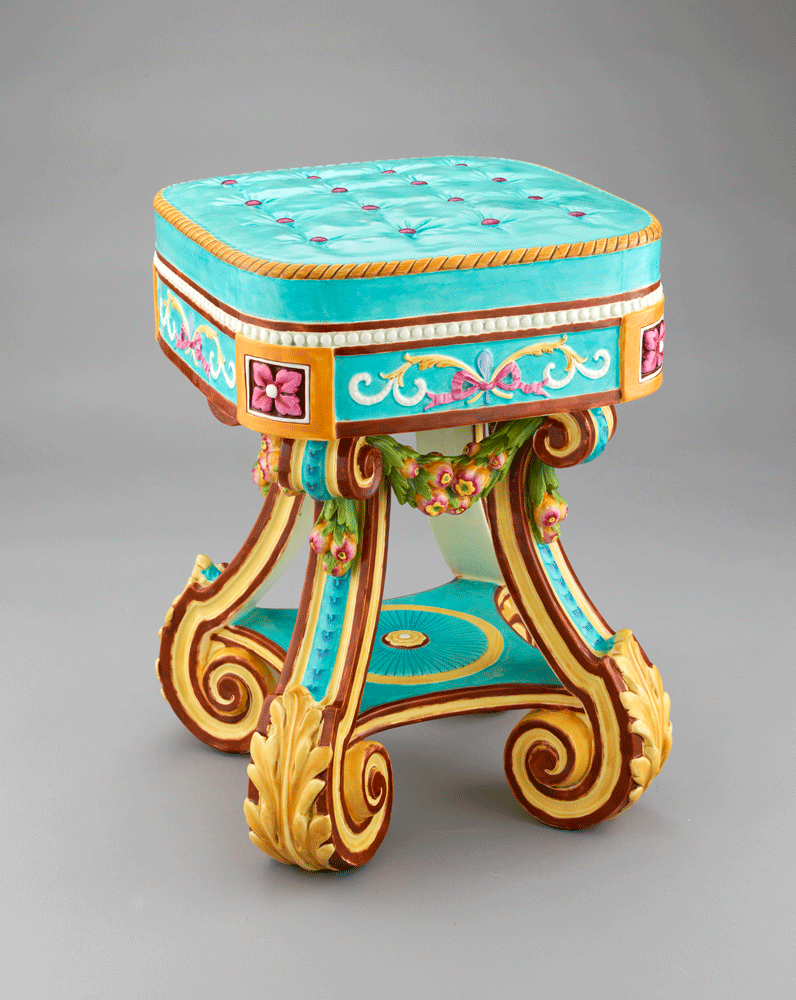
“"I Want Candy” scene in Marie Antoinette (2006)
Sofia Coppola’s 2006 film, Marie Antoinette is a slightly too pink, Manolo Blahnik and Converse shoe-wearing fantasy of Marie Antoinette’s life. The juxtaposition of Rococo pastels, modern shoes, and Bow Wow Wow’s “I want candy,” reinterprets the royal’s life in a modern sense and turns traditional period film genre on its head. The Rubens garden seat by Wedgwood also manages such a feat. It is ostentatious, shrouded in bright, fun colors, seemingly attempting to emulate the Rococo style. Yet, similarly to Coppola’s film, falls slightly off the mark in its failed efforts to “fit” into its intended time period.
Image: Josiah Wedgwood & Sons. Rubens Garden Seat, pattern no. M1401, this example 1873. Earthenware with majolica glazes, 17 7/8 × 13 × 13 in. (45.5 × 32.8 ×
32.8 cm). Impressed marks: WEDGWOOD // L // FAB // LLB; painted mark: M / 1401. The English Collection. Photo: Bruce White.
Wedgwood, Swan Pitcher, 1877
A Poem For the Swan Pitcher
By the BGC Interns
Artful vessel
Ruffled feathers
Stretched neck
Tension
Toiling
Diving, swooping
Living amongst grassy greenery
Creeping reeds and weeds
Fighting with nature
Resting, Upset
Small yellow eye
Emptiness inside
Green surrounding
Minton, Oyster Stand, designed 1855, made 1863
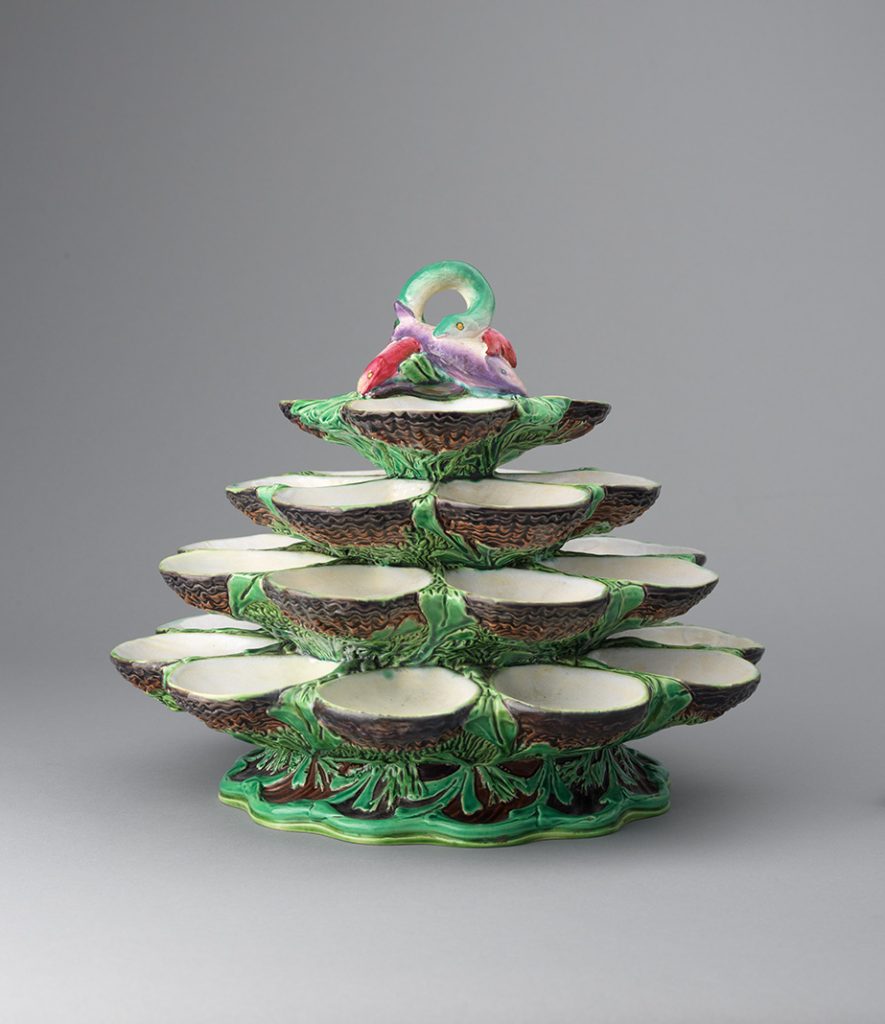
Mad Hatter Tea Party scene in Alice in Wonderland (2010)
“Sparkling Diamonds” scene in Moulin Rouge! (2001)
The tiered structure of the Minton Oyster Stand resembles that of a coral reef--this analogy is enhanced by the crossed fish that make up the stand’s handle, as well as its mossy green core. We have chosen two films, Tim Burton's Alice in Wonderland (2010) and Baz Luhrmann’s Moulin Rouge! (2001), in which we believe the Oyster Stand would thrive. We can imagine the Oyster Stand’s natural elements pairing well with the Mad Hatter’s tea party table, spread under an ominous sky. Likewise, we can envision the Oyster Stand amidst the opulence of the Moulin Rouge, not only for the specialized fare it serves, but also for its fun aesthetic. This object’s playfulness is well matched by the unconventional and captivating environments of both films.
Image: Minton & Co. Oyster Stand, shape no. 636, designed ca. 1855; this
example 1863. Earthenware with majolica glazes, h. 93/4 × diam. 121/4 in. (24.8 ×
31.2 cm). Impressed marks: MINTON // A // 636 // cipher for 1863. Joan Stacke
Graham Collection. Photo: Bruce White.
W.H. Edge for James Carr’s New York City Pottery, “George Washington Crossing the Delaware” Pedestal, c. 1876
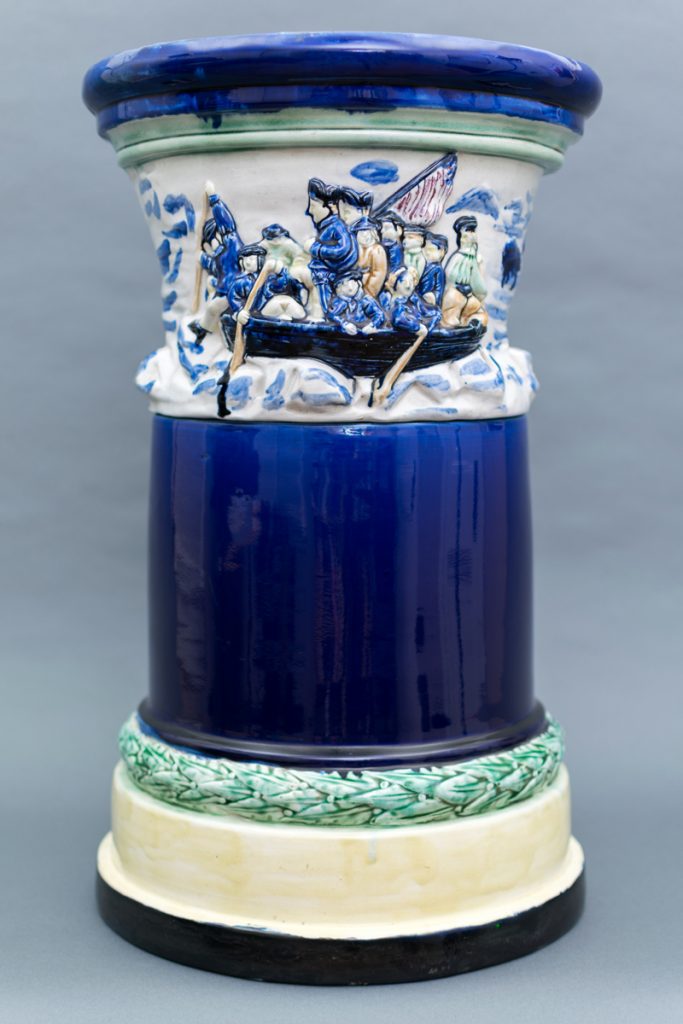
The Washington Crossing the Delaware pedestal seems based on Emanuel Leutze’s 1851 history painting, Washington Crossing the Delaware. Although both the pedestal and painting are hand painted, the pedestal’s recreation is somewhat crude in comparison to Leutze’s work in the way that it uses fewer strokes and far less detail. In addition, the usage of blue and white diverges from the original colors of the painting, and may reference blue and white porcelain, which had long been established as works of fine craftsmanship.
Image: Attributed to W. H. Edge (1835–1890), modeler; James Carr's New York City Pottery, manufacturer. George Washington Crossing the Delaware pedestal, ca. 1876. Earthenware with majolica glazes, h. 24 x dial. 14 1/2 in. (61 x 36.8 cm). Unmarked. Bryce Smith. Photo: Brandon Seekins.
T.C. Brown-Westhead, Moore & Co., Garden Seat, c. 1880

The Garden Seat by T. C. Brown-Westhead for Moore & Co. reminds me of Bastet, the Egyptian goddess of the home, and is here depicted as a black cat. Both pieces have women holding items, while wearing jewelry and embellished garments with striped patterns. In Egyptian culture, black cats were seen as the protectors of the home. The Garden Seat’s design is so decorative it can be symbolized as an item that guards the garden. I am aware the Majolica garden seat is a rude exaggeration of Egyptian culture. But I also see the garden seat and the Bastet sculpture resemble protective mothers guarding their homes.
Images: (Left) Bastet, Ancient Egypt, Late Period–Ptolemaic Period, 664–30 B.C. Metropolitan Museum of Art. Image Source: https://www.metmuseum.org/art/collection/search/551774
(Right) T. C. Brown-Westhead, Moore & Co. Garden seat, ca. 1880.
Earthenware with majolica glazes, 21 1/2 × 16 1/4 × 11 3/4 in. (54.6 × 41.3 × 29.9 cm). Unmarked. Joan Stacke Graham Collection. Photo: Bruce White.
Pierre-Émile Jeannest, Minton, Large Jardinière Shown at the Paris Exhibition Universelle of 1855, c. 1855
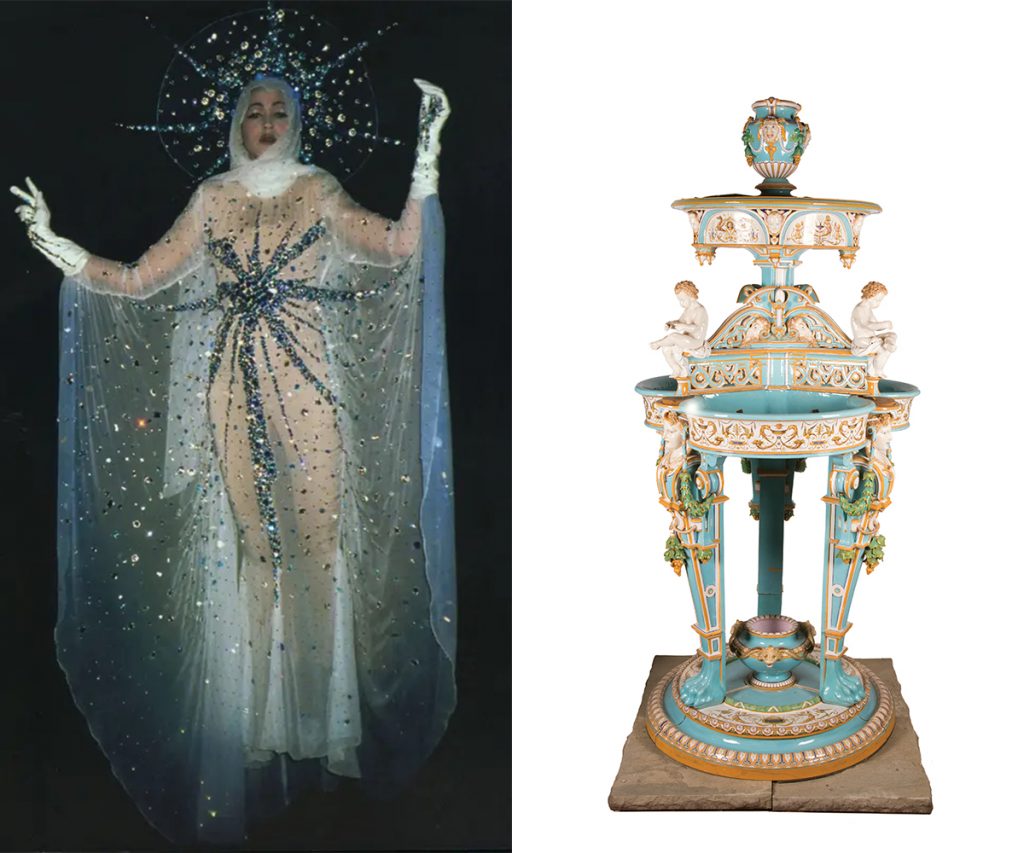
Spotify Playlist
“Young and Beautiful” by Lana Del Rey
“Swan Song” by Lana Del Rey
“In My Feelings” by Lana Del Rey
“Art Deco” by Lana Del Rey
“Gods and Monsters” by Lana Del Rey
“National Anthem” by Lana Del Rey
“Love” by Lana Del Rey
“Lust for Life” by Lana Del Rey and The Weeknd
“Cherry” by Lana Del Rey
“Chemtrails Over The Country Club” by Lana Del Rey
The combination of Lana Del Rey’s music, Thierry Mugler’s Madonna gown and Pierre-Émile Jeannest’s Large jardiniere shown at the Paris Exposition Universelle of 1855 amplifies and dramatizes fantasies of opulence. Young and Beautiful, a song written by Del Rey for Baz Lurhmann’s 2013 film, The Great Gatsby, describes the perspective of Daisy Buchanan, who questions her lover’s faithfulness. The lyrics are sad and emotional, but Del Rey sings in an ethereal tone that distracts the audience from the bitter reality of her lyrics. The song reminds me of the tiers of the Jardinière and the model levitating in Mugler’s Madonna ensemble. All three elements imply godliness, power, and riches, as well as a desire to sell the mirage of status.
Images: (Left) Thierry Mugler, Fall-Winter 1984-1985 ready-to-wear collection. Photo: Patrice Stable. Image Source: https://www.numero.com/en/fashion/thierry-mugler-in-9-cult-collections-montreal-museum-of-fine-arts-avant-gardist-fashion
(Right) Pierre-Émile Jeannest (1813–1857), designer; Minton & Co., manufacturer. Jardinier[e], ca. 1855. Earthenware with majolica glazes painted in enamels, H. 86 x diam. 43 1/2 in. (218.4 x 110.5 cm); base diam. 36 1/4 in. (92 cm). Painted on base in three places: MINTON & CO / STOKE-UPON-TRENT. The Potteries Museum & Art Gallery. Stoke-on-Trent, 1934P179.
Pierre-Émile Jeannest, Minton, Large Jardinière Shown at the Paris Exhibition Universelle of 1855, c. 1855

Spotify Playlist
“Young and Beautiful” by Lana Del Rey
“Swan Song” by Lana Del Rey
“In My Feelings” by Lana Del Rey
“Art Deco” by Lana Del Rey
“Gods and Monsters” by Lana Del Rey
“National Anthem” by Lana Del Rey
“Love” by Lana Del Rey
“Lust for Life” by Lana Del Rey and The Weeknd
“Cherry” by Lana Del Rey
“Chemtrails Over The Country Club” by Lana Del Rey
The combination of Lana Del Rey’s music, Thierry Mugler’s Madonna gown and Pierre-Émile Jeannest’s Large jardiniere shown at the Paris Exposition Universelle of 1855 amplifies and dramatizes fantasies of opulence. Young and Beautiful, a song written by Del Rey for Baz Lurhmann’s 2013 film, The Great Gatsby, describes the perspective of Daisy Buchanan, who questions her lover’s faithfulness. The lyrics are sad and emotional, but Del Rey sings in an ethereal tone that distracts the audience from the bitter reality of her lyrics. The song reminds me of the tiers of the Jardinière and the model levitating in Mugler’s Madonna ensemble. All three elements imply godliness, power, and riches, as well as a desire to sell the mirage of status.
Images: (Left) Thierry Mugler, Fall-Winter 1984-1985 ready-to-wear collection. Photo: Patrice Stable. Image Source: https://www.numero.com/en/fashion/thierry-mugler-in-9-cult-collections-montreal-museum-of-fine-arts-avant-gardist-fashion
(Right) Pierre-Émile Jeannest (1813–1857), designer; Minton & Co., manufacturer. Jardinier[e], ca. 1855. Earthenware with majolica glazes painted in enamels, H. 86 x diam. 43 1/2 in. (218.4 x 110.5 cm); base diam. 36 1/4 in. (92 cm). Painted on base in three places: MINTON & CO / STOKE-UPON-TRENT. The Potteries Museum & Art Gallery. Stoke-on-Trent, 1934P179.
Click Objects Above to Explore

Chesapeake Pottery/Haynes, Lamp, c. 1882-1886
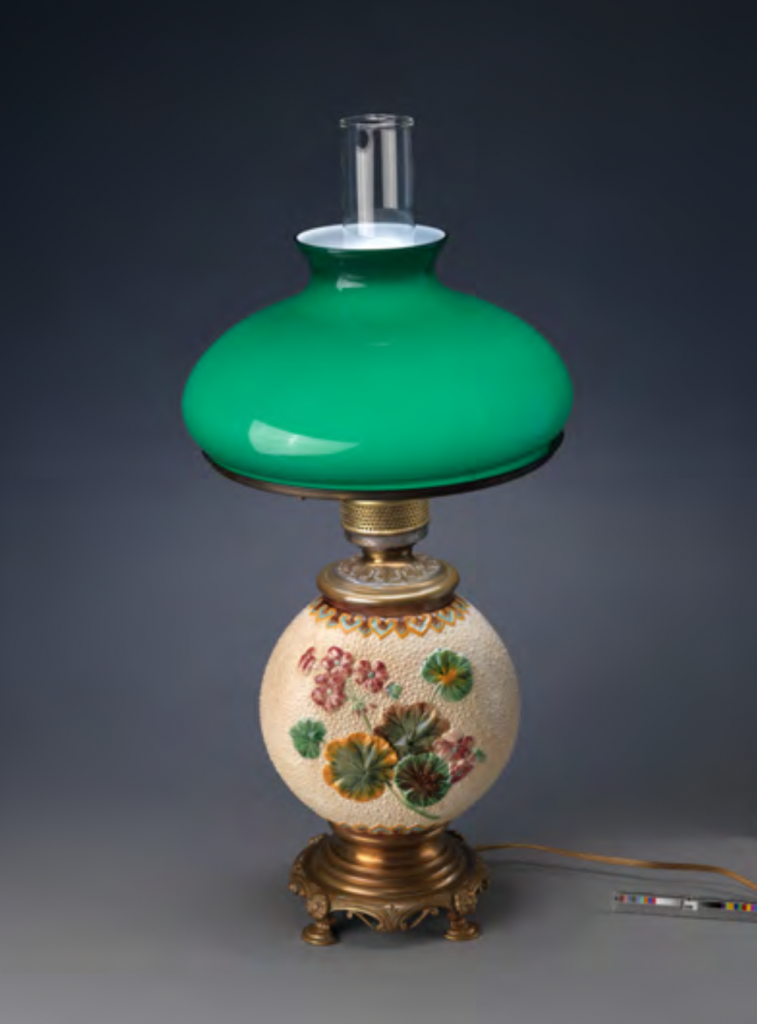
The majolica lamp asks a similar question. Its shape and coloration recall lamps designed by Louis Comfort Tiffany in the late nineteenth and early twentieth centuries. But this lamp seems to lack the applause of a Tiffany lamp, which can be seen in the permanent collection of the Metropolitan Museum of Art. Tiffany lamps also find themselves being worked into several high art exhibitions like, Camp: Notes on Fashion (2019) and American Impressionism and Realism: The Painting of Modern Life, 1880–1920 (1994). Unlike Lamp, a Tiffany lamp is not bound to a singular theme, it exists and can be viewed independently, whereas the majolica Lamp is best appreciated when tied to its majolica family unit.
Image: D. F. Haynes & Co., Chesapeake Pottery. Lamp, ca. 1882–86. Earthenware with majolica glazes, glass, brass, and other metal, h. 24 × diam. 11 3/8 in. (61 × 28.8 cm). Unmarked. John Collier Collection. Photo: Bruce White.
Hugues Protât, Wedgwood, Mermaid Vase Form Clock, c. 1871

Spotify Playlist
“Adaptation” by The Weeknd
“Pretty” by The Weeknd
“Nothing Compares” by The Weeknd
“I Was Never There” by The Weeknd and Gesaffelstein
“Heaven or Las Vegas” by The Weeknd
“Wicked Games” by The Weeknd
“Dark Times” by The Weeknd and Ed Sheeran
“Prisoner” by The Weeknd
“After Hours” by The Weeknd
“As You Are” by The Weeknd
Hugues Protât’s Mermaid vase form clock and Thierry Mugler’s La Chimère gown both include haunting and monstrous mythical creatures. The mermaids’ posture on either side of the clock makes them seem confined and agonized. La Chimère’s colors are dark and pigmented, hinting at the horrors--and sins--the creature could cause. Both share a similar palette of blues and yellows. The combination of these two objects also reminds me of The Weeknd’s music because his lyrics describe upsetting and dark scenes. However, his angelic voice creates a balance so that his listeners do not feel confined themselves. Taken together, this collection of objects and performances uncover the darkness within dramatized fantasies.
Images: (Left) Thierry Mugler, La Chimère collection, haute couture Fall/Winter 1997-1998. Photographed by Alan Strutt, Model: Yasmin Le Bon.
Image Source: https://madparis.fr/en/about-us/exhibitions/forthcoming-exhibitions/musee-des-arts-decoratifs/thierry-mugler-couturissime/#&gid=1&pid=7
(Right) Hugues Protât, (born 1816; active 1835–90), designer. Mermaid Clock Vase, pattern no. M1719, shape designed ca. 1871. Wedgwood. Earthenware with majolica glazes, metal, glass and other materials. Impressed marks: wedgwood // mb[?] // 1. Aviva and Gerald Leberfeld. Photo: Bruce White.
Henry Hope Crealock, Minton for Thomas Goode & Co., Vulture and Serpent Teapot, Shape no. 1851, designed 1873, made 1874
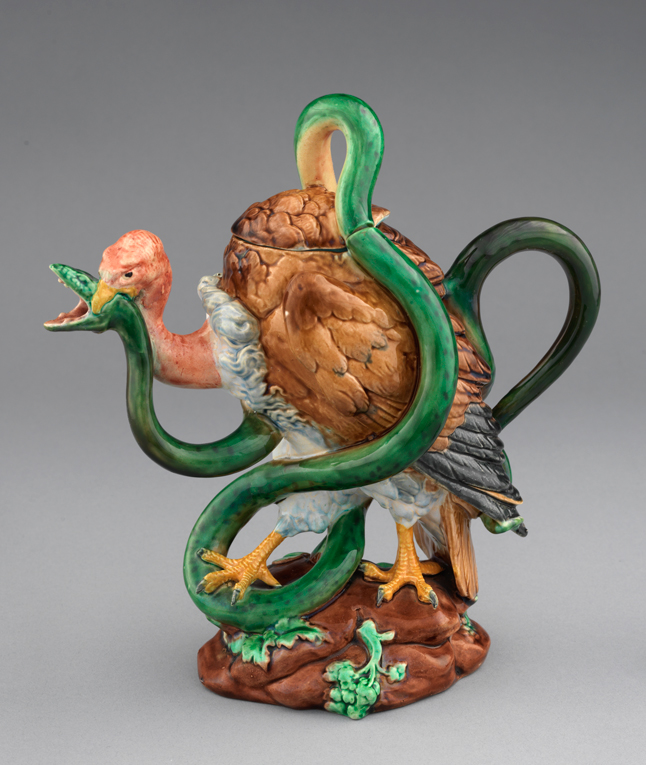
Spotify Playlist
“Suzanne” by Leonard Cohen
“The Killing Moon” by Echo & the Bunnymen
“Severed” by The Decemberists
“The Wild Kindness” by Silver Jews
“Vulture Culture” by Fangclub
“As wise as a Serpent” by Gerry Rafferty
This collection of songs reflects the grisly image of the vulture and the snake and exposes the vulture’s inevitable violence,as well as the inescapable brutality found in the nature of humans and animals. “The Killing Moon” explains the fated nature of the scene, while “Vulture Culture” and “Severed” give voice to the vulture’s destructive intent. “As Wise as a Serpent” looks through the eyes of the snake and establishes a gentler voice as a counterweight to the grating screech of the vulture. Lastly, “Suzanne” stands in contrast to the clear malice of the teapot’s form and provides insight to the peaceful and lulling rituals of making and drinking tea.
Image: Henry Hope Crealock (1831–1891). Vulture and serpent teapot, shape no. 1851, Designed 1873, this example made 1874. Minton for Thomas Goode & Co.. Earthenware with majolica glazes. Impressed marks: MINTON, year cipher for 1874, two other ciphers; painted mark: 12. Joan Stacke Graham Collection. Photo: Bruce White.
Minton, Cheese dish in the form of a bee skep with blackberry briar, c. 1862

Spotify Playlist
“Honey, Honey” by ABBA
“Be Sweet” by Japanese Breakfast
“In a Week” by Hozier and Karen Cowley
“Waterloo” by ABBA
“Sweet Disposition” by The Temper Trap
“Sunflower” by Post Malone and Swae Lee
“Superfly” by BLESSED
“Valerie” by Amy Winehouse and Mark Ronson
In collecting songs for the cheese dish, we focused on its bee skep form—a woven basket pattern rendered in ceramic and embellished with vines and blackberries. We contemplated how this object might start its day, and this thought helped guide the patterns and movement of the playlist we created to complement the cheese dish. Our playlist begins softly (“Honey Honey”), then becomes more upbeat (“Be Sweet”), before dipping (“In a Week”), and ending on a joyful, honeyed high.
Image: Cheese stand, shape no. 969, design registered 1862. Minton. Earthenware with majolica glazes, 13 1/8 x 10 1/2 x 10 1/4 in. (33.4 x 26.8 x 26.1 cm). Impressed marks: MINTON // 969 // British registry diamond for April 4, 1862, parcel 2. Joan Stacke Graham Collection. Photo: Bruce White.
Modeled by Claude Michel (Clodion), Wedgwood, Figure of a “Bacchante,” c. 1862
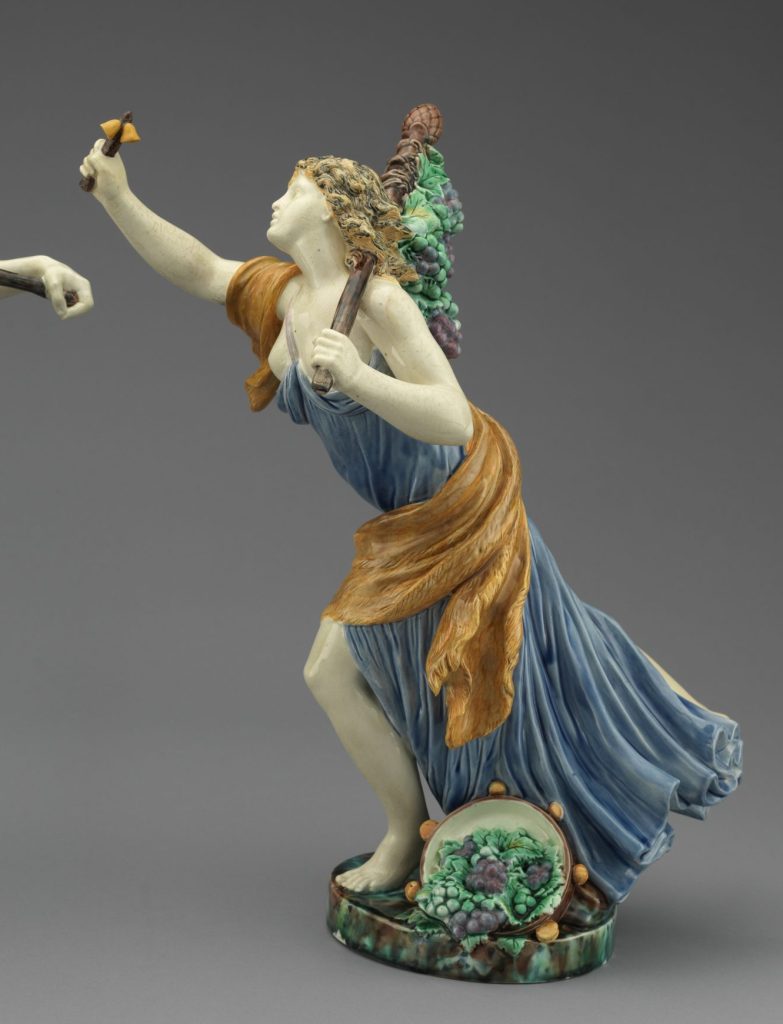
Kore
By Frederic Manning, 1909
Yea, she hath passed hereby, and blessed the sheaves,
And the great garths, and stacks, and quiet farms,
And all the tawny, and the crimson leaves.
Yea, she hath passed with poppies in her arms,
Under the star of dusk, through stealing mist,
And blessed the earth, and gone, while no man wist.
With slow, reluctant feet, and weary eyes,
And eye-lids heavy with the coming sleep,
With small breasts lifted up in stress of sighs,
She passed, as shadows pass, among the sheep;
While the earth dreamed, and only I was ware
Of that faint fragrance blown from her soft hair.
The land lay steeped in peace of silent dreams;
There was no sound amid the sacred boughs.
Nor any mournful music in her streams:
Only I saw the shadow on her brows,
Only I knew her for the yearly slain,
And wept, and weep until she come again.
The Bacchante figure is dressed in the spring colors of deep yellow and pale blue, has her hand outstretched, and clutches a fistful of flowers. Her youthful motion can thus be compared to the dynamic and earnest poem: Kore by Frederic Manning. Manning writes a tribute to Persephone and all maidens who relish the sun and its flowers, but in some way, whether by abduction, age, responsibility, or the unstoppable changing of the seasons, must forfeit their environment. Kore’s joy in springtime is undercut by the melancholy of its end, and yet her contentment burns as brightly as that of the bacchante figure captured in motion, running through the fields.
Image: After Claude Michel, called Clodion (1738–1814); Josiah Wedgwood & Sons, manufacturer. Figures of a bacchante (right), this example ca. 1862. Earthenware with majolica glazes, 16 1/2 × 8 × 14 1/2 in. (41.8 × 20.2 × 37 cm). Impressed marks: WEDGWOOD // T. The English Collection. Photo: Bruce White.
Modeled by Claude Michel (Clodion), Wedgwood, c. 1862
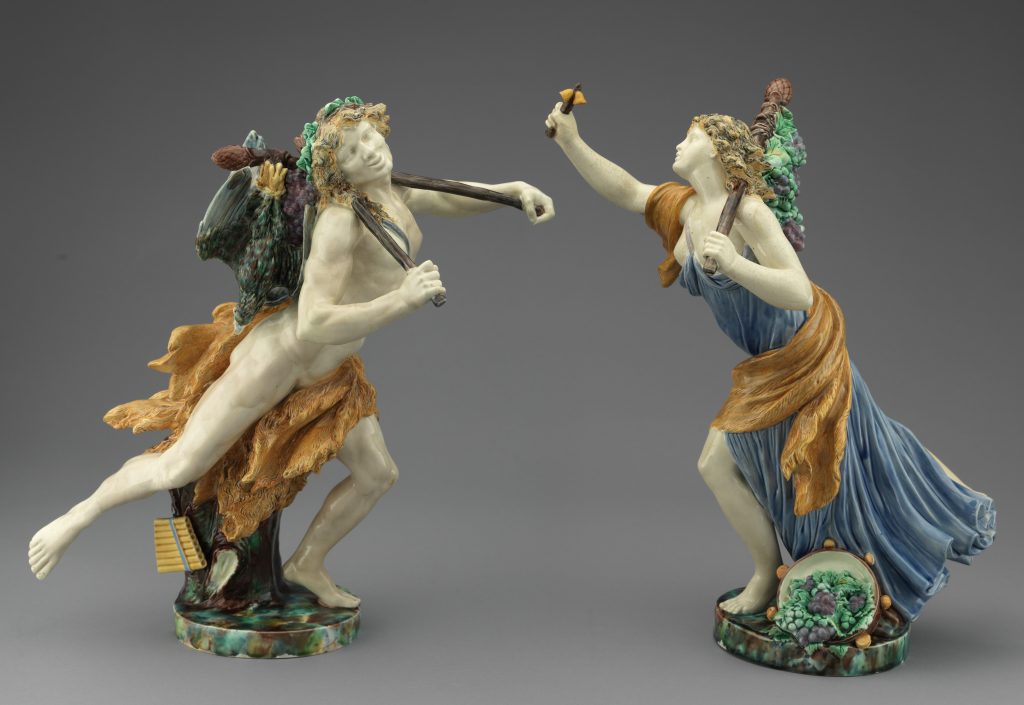
Image: After Claude Michel, called Clodion (1738–1814); Josiah Wedgwood & Sons, manufacturer. Figures of a faun (left) and bacchante (right), these examples ca. 1862. Earthenware with majolica glazes, faun: 16 1/4 × 83/8 × 15 5/8 in. (41.2 × 21.2 × 39.6 cm); bacchante: 16 1/2 × 8 × 14 1/2 in. (41.8 × 20.2 × 37 cm). Faun, impressed mark: WEDGWOOD; bacchante, impressed marks: WEDGWOOD // T. The English Collection. Photo: Bruce White.
Click Objects Above to Explore
Student Contributors
Caroline Arenas Lopez is 18 years old, a rising sophomore at Fashion Institute of Technology living in Bronx, NY. After getting her AAS degree in Fashion Design, Caroline wants to study advertising and marketing communications, and study abroad in London, England to explore the business side of fashion with people from different backgrounds.
Zoe Bunce is a rising freshman at Bates College. She is a ceramicist and an aspiring painter who relishes learning history by tracking the hands of artists. Zoe looks forward to learning more about how different peoples have been able to take advantage of art in the fight for social and political reform. She plans on studying abroad in Latin America to further explore this essential ingredient to revolutionary movements. In her free time, she loves to watch musicals, read books, and bake treats.
Endie Hwang is a rising sophomore at Washington University in St. Louis. She is interested in history and philosophy, and seeks to understand how past behaviors have shaped the world. Endie enjoys spending time in various cultural institutions and is interested in learning about the artwork housed within them, as well as the inner workings of such institutions. In her free time she bakes and draws.
